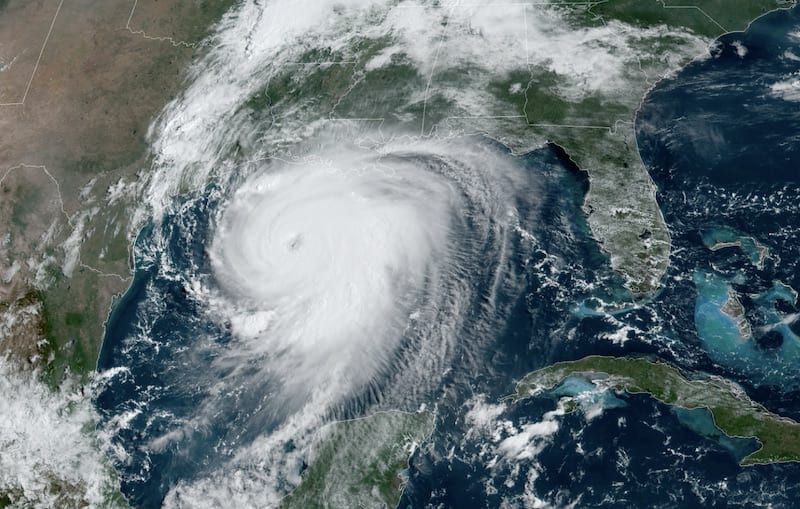Hurricane Laura pictured at approximately 11 a.m. ET, August 26, 2020. Image courtesy NOAA/GOES-East

By Erwin Seba HOUSTON, Aug 26 (Reuters) – Laura intensified into a strong Category 4 hurricane on Wednesday as it raced over evacuated oil production platforms in the U.S. Gulf of Mexico and took aim at the energy industry’s refining hub along the Texas/Louisiana coast.
The storm gathered strength on Wednesday and is forecast to bring heavy rains and catastrophic, 150 mile-per-hour (240 kph) winds that will drive ocean waters up to 40 miles (64 km) inland, U.S. forecasters said in a late-day advisory.
More than 600,000 people in the two states fled the storm, clogging highways and filled hotels in a rush to avoid the storm and shelters. Both states secured hotel rooms for evacuees and warned residents to avoid traveling overnight.
Landfall is expected at about midnight (0500 GMT Thursday) and could push an “unsurvivable” 20-foot (6-m) wall of water against the coast south of Lake Charles, Louisiana, the National Hurricane Center warned.
The storm’s track and power resembles 2005’s Hurricane Rita, which caused more than $18 billion in damages and killed more than 120 people, many during a hurried Texas evacuation.
“The storm surge is going to be catastrophic, easily a 10- to 15-foot (3-4.6 m) surge on top of five to 10 inches (13-25 cm) of rain,” near the center, said Jim Foerster, chief meteorologist at DTN, an energy, agriculture and weather data provider.
Laura’s projected path spares Houston, the fourth largest city in the United States, and has allowed some of its oil refineries to keep running. But it will bring a deadly combination of fierce winds, blinding rainfall and storm surge to communities along the Texas/Louisiana state line that were severely affected by Hurricane Harvey’s floods three years ago.
Hurricane force winds will extend up to 60 miles from the storm center, the NHC said, encompassing an area with a half-dozen large oil refineries and natural-gas processing plants. Cheniere Energy Inc, the top exporter of U.S. liquefied natural gas, evacuated a plant near the storm’s path, and Cameron LNG also closed its Louisiana LNG export plant.
The ports of Lake Charles, Louisiana, and Houston, Beaumont, Port Arthur and Orange, Texas, closed to vessel traffic on Wednesday, the U.S. Coast Guard said.
Six oil-processing plants that convert nearly 2.33 million barrels per day of oil into fuel, and account for about 12% of U.S. processing were shut down on Wednesday.
Chevron Corp, Exxon Mobil Corp, Valero Energy, Total and Motiva Enterprises had halted operations at oil refineries in the area on Wednesday.
Oil producers on Wednesday had evacuated 310 offshore oil facilities and shut 84%, or 1.56 million bpd, of U.S. Gulf of Mexico crude output, and 61% of the region’s offshore natural gas production.
As the storm took aim at the Texas/Louisiana border, refiners closer to Houston were expecting to ride it out.
Marathon Petroleum Corp’s Galveston Bay Refinery in Texas City, LyondellBasell’s Houston facility and Exxon’s Baytown refinery were continuing operations, according to people familiar with the matter.
Marathon and LyondellBasell did not have immediate responses. Exxon’s Baytown plant is running but was taking precautions in event conditions worsen, a spokesman said.
(Reporting by Erwin Seba; writing by Gary McWilliams Editing by Marguerita Choy and Grant McCool)
(c) Copyright Thomson Reuters 2020.

 Join The Club
Join The Club











